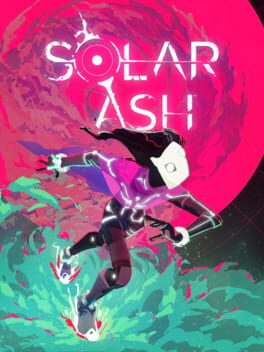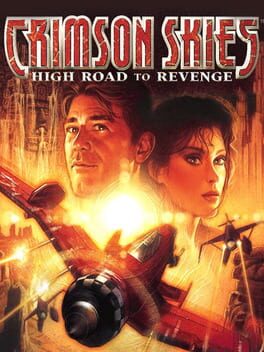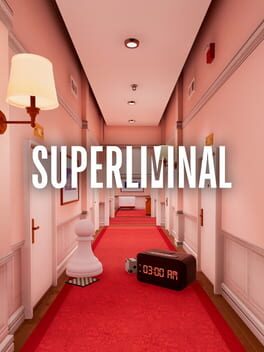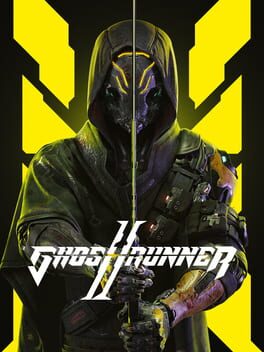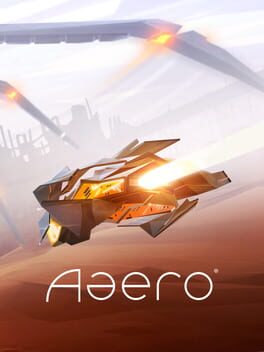brentsacks
85 reviews liked by brentsacks
Solar Ash
2021
After Hyper Light Drifter, I was definitely excited to see what Heart Machine (again with Disasterpiece's soundtrack on board) would come up with with their first 3D game. Especially since it's basically a 3D platformer focused on momemtum and speed. And honestly, I was definitely not disappointed.
The premise alone is one of my favorite in video games: The protagonist's planet is about to be sucked up by a black hole, and she descends into the black hole to destroy it. Within the black hole are fragments of worlds that have already been absorbed, connected to purple clouds over which you can surf. An incredibly cool concept in my opinion.
And it plays great and lets you marvel at the beautiful and melancholic world design again and again. The core gamplay loop consists of destroying anomalies with the help of parkoure challenges. Sounds a bit abstract, but that's the best way to sum it up. The problem here is that this loop gets repetitive very quickly and isn't expanded enough with new challenges or more skills. What kept me going were the new worlds, but not the new challenges. Sure, lava floors are used here and timetrials there to add variety to the parkour challenges. But despite that, since the moveset remains the same until the end, a certain routine arises. Get to a new area, destroy 5 anomalies with parkour and destroy the boss. The story is also relatively unimportant; I only noticed the side characters and their fates peripherally.
The world design and general feeling of gliding above the clouds is so strong that I was drawn into this world. And I'm really surprised that, objectively speaking, there aren't that many aspects here that really excite me. However, the movement and atmosphere of the world are so strong that I am simply enchanted. They could have dropped the voice acting and the detailed lore dumping and left everything just as mysterious and vague as in Hyper Light Drifter. Then it would be much more popular with me.
The premise alone is one of my favorite in video games: The protagonist's planet is about to be sucked up by a black hole, and she descends into the black hole to destroy it. Within the black hole are fragments of worlds that have already been absorbed, connected to purple clouds over which you can surf. An incredibly cool concept in my opinion.
And it plays great and lets you marvel at the beautiful and melancholic world design again and again. The core gamplay loop consists of destroying anomalies with the help of parkoure challenges. Sounds a bit abstract, but that's the best way to sum it up. The problem here is that this loop gets repetitive very quickly and isn't expanded enough with new challenges or more skills. What kept me going were the new worlds, but not the new challenges. Sure, lava floors are used here and timetrials there to add variety to the parkour challenges. But despite that, since the moveset remains the same until the end, a certain routine arises. Get to a new area, destroy 5 anomalies with parkour and destroy the boss. The story is also relatively unimportant; I only noticed the side characters and their fates peripherally.
The world design and general feeling of gliding above the clouds is so strong that I was drawn into this world. And I'm really surprised that, objectively speaking, there aren't that many aspects here that really excite me. However, the movement and atmosphere of the world are so strong that I am simply enchanted. They could have dropped the voice acting and the detailed lore dumping and left everything just as mysterious and vague as in Hyper Light Drifter. Then it would be much more popular with me.
Solar Ash
2021
The good news about trying out Solar Ash is that it clicked immediately since it was not afraid to wear its influences on its sleeves: you’ve got skating mechanics inspired by Jet Set Radio, boss fights and designs inspired by Shadow of the Colossus, and a woozy ambient soundtrack alongside gooey and ethereal aesthetics captured in deep space. It’s not hard to decipher Heart Machine’s vision for the game. The bad news about trying out Solar Ash is that being so heavily inspired by two of my favorite games meant that I was both consciously and unconsciously comparing the game in every waking moment of my playthrough, and the cracks in the armor really started to show. Right away, the most obvious issue is the lack of subtlety. The game is so in-your-face with its lore and the overarching details that it fails to leave much room for individual player interpretation. The protagonist Rei is constantly commenting upon everything she comes across, and the audio logs that she stumbles upon where her old crewmates vividly describe the world’s demise don’t leave much up to imagination either. This over-explanation is further compounded by all the jargon thrown into the mix and the exaggerated voice acting, which not only confuses me, but also feels like the authors didn’t really tackle the tone properly; instead of sounding desperate, Rei instead comes off as somewhat angsty to me. The amount of effort put into flaunting all this detail feels quite unwarranted, considering that Shadow of the Colossus was more than happy to let players just linger in their own space and judge for themselves: what happened to “show, don’t tell” guys?
Further invited comparisons to Shadow of the Colossus make it evident to me that despite the reverence of its boss encounters, Solar Ash fails to emulate much of their appeal in any meaningful way. Nothing comes close to the volume swells present in Shadow of the Colossus, because there’s no focused build-up of anticipation when the player is too busy looking for plasma and voidrunner caches alongside traversal puzzles for destroying Anomalies, not to mention Rei’s stream of self-narration breaking up any prolonged moments of silence. More importantly, the boss fights themselves lack any stakes. Shadow of the Colossus emphasizes its sense of scale, as you carefully climb this larger-than-life creature while it desperately flails about, trying to shake you off before you snuff it out by plunging your sword into its vitals. Solar Ash on the other hand, may as well just be a casual Sunday drive through a Mario Kart course; the sigils have been replaced with temporary targets and context-sensitive grapple points, and most of the interaction boils down to holding forward on the joystick and jumping/grappling at the right time. You don’t even need to adjust the camera, because the game will automatically do that for you when you need to shift directions. Say what you want about Shadow of the Colossus’ ballistic camera during the colossi encounters, but it really lent the fights a sense of powerlessness and urgency during this desperate dance of death that Solar Ash lacks. To top this all off, consequences of failure are minimized in the latter; falling off or failing to hit a target in time just sends you back to a close checkpoint to the boss with only one hit point missing, and you can usually grapple right back on the boss to retry the phase within a minute or two. Considering that health boxes are scattered everywhere, you have to actively try to get a game over. It is kind of funny that the final boss fight doesn’t even provide you with a health bar for a potential game over: it’s a mere formality at that point.
The weird thing is, despite how streamlined the boss fights are in Solar Ash, there’s a real lack of polish from strange jank and design decisions elsewhere. Rei’s standard attack combo string consists of three attacks at a time, but the game likes throwing enemy variations at you that require four hits at a time (either a pair of smaller foes that each take two hits, or a singular medium baddy that takes four hits). The result is that you have to actively linger in the same space to completely finish off most enemies, and combat then noticeably interferes with the general flow of movement. Regarding lack of fluidity, I also have to agree with nex3’s point that it’s surprisingly easy to lose momentum altogether from strange collisions due to geometry. The strange momentum physics are reflected elsewhere too, such as when I noticed that jumping from the end of a rail resulted in significantly less momentum conserved than when Rei naturally slid off the rail instead. Finally, it’s kind of a shame that despite how much plasma is thrown at you and emphasized as the main collectible resource (to the point where one of the unlockable suits doubles your rate of plasma collection), there’s only one use for it: restoring a block of your health gauge’s max capacity after losing a cell every time you defeat a boss. In that sense, plasma feels rather superfluous, much like most of the game’s mechanics and features outside of its core traversal.
In spite of all this, I liked Solar Ash enough to complete a save file. I can’t help but feel bummed though, because I should have loved this. I had a good enough time just gliding about the surface of a post-apocalyptic wasteland and zooming about from rail to rail, but there’s so much stuff in-between that doesn’t seem to add anything pertinent to the base structure. I can’t see myself coming back to this for hardcore mode unfortunately, since it just seems like an artificially difficult no-hit playthrough with extra steps, though perhaps I’ll return someday to see if a speedrun challenge feels any better than a standard run. I find myself agreeing with quite a few others here: if practically everything minus the atmospheric visuals/soundtrack and core traversal mechanics were removed, you might actually have one of the most compact yet focused experiences of recent times. As it is now though? It’s just fine. It’ll always be I suppose.
Further invited comparisons to Shadow of the Colossus make it evident to me that despite the reverence of its boss encounters, Solar Ash fails to emulate much of their appeal in any meaningful way. Nothing comes close to the volume swells present in Shadow of the Colossus, because there’s no focused build-up of anticipation when the player is too busy looking for plasma and voidrunner caches alongside traversal puzzles for destroying Anomalies, not to mention Rei’s stream of self-narration breaking up any prolonged moments of silence. More importantly, the boss fights themselves lack any stakes. Shadow of the Colossus emphasizes its sense of scale, as you carefully climb this larger-than-life creature while it desperately flails about, trying to shake you off before you snuff it out by plunging your sword into its vitals. Solar Ash on the other hand, may as well just be a casual Sunday drive through a Mario Kart course; the sigils have been replaced with temporary targets and context-sensitive grapple points, and most of the interaction boils down to holding forward on the joystick and jumping/grappling at the right time. You don’t even need to adjust the camera, because the game will automatically do that for you when you need to shift directions. Say what you want about Shadow of the Colossus’ ballistic camera during the colossi encounters, but it really lent the fights a sense of powerlessness and urgency during this desperate dance of death that Solar Ash lacks. To top this all off, consequences of failure are minimized in the latter; falling off or failing to hit a target in time just sends you back to a close checkpoint to the boss with only one hit point missing, and you can usually grapple right back on the boss to retry the phase within a minute or two. Considering that health boxes are scattered everywhere, you have to actively try to get a game over. It is kind of funny that the final boss fight doesn’t even provide you with a health bar for a potential game over: it’s a mere formality at that point.
The weird thing is, despite how streamlined the boss fights are in Solar Ash, there’s a real lack of polish from strange jank and design decisions elsewhere. Rei’s standard attack combo string consists of three attacks at a time, but the game likes throwing enemy variations at you that require four hits at a time (either a pair of smaller foes that each take two hits, or a singular medium baddy that takes four hits). The result is that you have to actively linger in the same space to completely finish off most enemies, and combat then noticeably interferes with the general flow of movement. Regarding lack of fluidity, I also have to agree with nex3’s point that it’s surprisingly easy to lose momentum altogether from strange collisions due to geometry. The strange momentum physics are reflected elsewhere too, such as when I noticed that jumping from the end of a rail resulted in significantly less momentum conserved than when Rei naturally slid off the rail instead. Finally, it’s kind of a shame that despite how much plasma is thrown at you and emphasized as the main collectible resource (to the point where one of the unlockable suits doubles your rate of plasma collection), there’s only one use for it: restoring a block of your health gauge’s max capacity after losing a cell every time you defeat a boss. In that sense, plasma feels rather superfluous, much like most of the game’s mechanics and features outside of its core traversal.
In spite of all this, I liked Solar Ash enough to complete a save file. I can’t help but feel bummed though, because I should have loved this. I had a good enough time just gliding about the surface of a post-apocalyptic wasteland and zooming about from rail to rail, but there’s so much stuff in-between that doesn’t seem to add anything pertinent to the base structure. I can’t see myself coming back to this for hardcore mode unfortunately, since it just seems like an artificially difficult no-hit playthrough with extra steps, though perhaps I’ll return someday to see if a speedrun challenge feels any better than a standard run. I find myself agreeing with quite a few others here: if practically everything minus the atmospheric visuals/soundtrack and core traversal mechanics were removed, you might actually have one of the most compact yet focused experiences of recent times. As it is now though? It’s just fine. It’ll always be I suppose.
In the vein of Indiana Jones or The Rocketeer, Crimson Skies: High Road to Revenge has a raucously pulpy tone, is surprisingly well-written and voiced, and is an absolute blast to play. It's always a little startling to run into a 6th generation game that has held up so well, comparatively speaking. It even looks pretty damn great.
Superliminal
2019
A Short Hike
2019
There is pretty much nothing wrong with this game, it gets exactly what it wants accomplished in the timeframe given and doesn't overstay its welcome. Play as much as you'd like and explore as much as you'd like, it's all up to you. And there is a lot to do in this game that can be as short or as long as you'd want it to be! I myself spent a good chunk of time fishing before I finally bothered finishing my climbing and flying. It's a good time, and I'd have no reservations recommending this to anyone looking for a wholesome yet adventurous experience.
Ghostrunner II
2023
This is just a straight upgrade over the original in pretty much every way. Better combat, better level design, better bosses, better story. If I were to have one complaint it would be that it’s greatest new addition is introduced in the very last level so it doesn’t feel like it gets as fleshed out as it could so I hope a sequel comes out that revolves around it.
